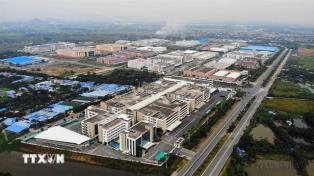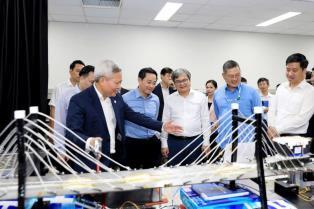It’s not about money: structural barriers blocking Việt Nam’s public investment
Kinh tế & Đô thị (Economic and Urban Affairs) newspaper spoke with Nguyễn Sĩ Dũng, member of the Prime Minister’s Policy Advisory Council and former deputy director of the National Assembly Office, about what’s holding things up and what it would take to get them moving.

Việt Nam’s public investment programmes – the engine behind new highways, ports and infrastructure – are once again moving more slowly than expected. As of mid-October, only about half of the year’s funds had been disbursed, despite an all-out push from the Government.
Kinh tế & Đô thị (Economic and Urban Affairs) newspaper spoke with Nguyễn Sĩ Dũng, member of the Prime Minister’s Policy Advisory Council and former deputy director of the National Assembly Office, about what’s holding things up and what it would take to get them moving.
Despite constant directives from the top, disbursement remains far below target. What’s really holding it back?
The core problem isn’t a lack of will; it’s a system that’s too rigid to move. Việt Nam’s public investment law is tight on the input side, with endless layers of approval, but weak on the output side, where flexibility and accountability should be.
Every project has to crawl through a maze of paperwork. By the time construction actually begins, months or even years have been lost, and the capital is effectively locked inside the bureaucracy.
This 'command-and-control' mindset kills initiative, leaving project owners and contractors waiting passively for approval, rather than solving problems themselves.
We also decentralise responsibilities, but not authority. Local governments get assigned budgets but can’t adjust project lists or move money around when something changes.
If land prices rise or a design needs tweaking, they have to report all the way up to the central level, losing months in the process.
Then there’s psychology. Many officials are scared to act. When the legal framework is unclear, doing nothing feels safer than taking responsibility. 'Better to be slow than wrong' has become an unspoken rule.
At the same time, implementation capacity hasn’t kept pace with reforms. Many project managers still lack modern management skills or familiarity with digital oversight tools, and without that foundation, small issues can pile up unnoticed until it’s too late.
Just as important, there’s still no built-in feedback or learning process across the life cycle of a project. When delays happen, the instinct is simply to push harder, not to ask why they occurred, where the bottleneck lies or how to prevent a repeat.
Advanced economies build this into what’s known as a project-governance cycle: measuring, evaluating, feeding back and improving continuously. Until Việt Nam does the same, old mistakes will keep resurfacing instead of becoming lessons.
So yes – the problem isn’t with individuals, but with the structure itself. Until we shift from rule-issuing to policy operations, from project administration to investment governance, and from controlling inputs to assessing results, the system will continue to be hindered by its own complexity.
Local authorities often blame land clearance for the delays. The Government has already allowed provinces and cities to manage this independently. Why hasn’t that helped?
The decision to separate land clearance from main projects was a big step forward. But good policy is only half the story; the rest depends on how it’s executed.
First, our legal framework on land and compensation is still unstable. There’s a persistent gap between legal land prices and real market values. This 'valuation mismatch' creates endless disputes. Unless we allow more flexible, market-based pricing, local governments will continue to struggle to reach agreements with residents.
The way we organise land clearance at the local level also remains fragmented. Many provinces and cities still lack professional land-fund development centres. Responsibilities are scattered between departments of natural resources and construction and compensation boards. That makes coordination extremely slow.
In many countries, this is handled by specialised land management agencies – independent bodies that consolidate data, valuation and social dialogue under one roof. That’s what we need to emulate.
Meanwhile, decentralisation has outpaced capacity. Some provinces and cities simply don’t have accurate cadastral maps or digital land databases. They lack valuation experts, and often no one on the team understands the social dimension of relocation. So even when they have authority, they don’t have the means to use it effectively.
Another challenge lies in trust. Land clearance isn’t a technical issue; it’s a matter of social legitimacy. If people believe the process is transparent and fair, they cooperate. If they don’t, they refuse. The key is communication – explaining the public interest clearly and ensuring citizens feel respected. Fast clearance only happens when it’s transparent and humane.
Finally, we need a more structured way to learn from experience. If each clearance project kept an up-to-date record of progress, obstacles and causes of delay, the central Government could spot problems early, coordinate faster, and share lessons across regions.
That kind of simple, data-driven feedback loop can turn short-term fixes into long-term institutional learning.
Lawmakers have blamed both the capital allocation process and weak project preparation at local levels. Do you see this as part of the same problem?
Completely. Those are symptoms of deeper flaws in the way our institutions are designed.
At the moment, capital allocation is still largely administrative – it's more about completing the plan than ensuring readiness. Many projects get funding when they’re not even legally or technically prepared to begin. So the money just sits there, unused.
In advanced systems, public investment only flows once projects pass a readiness assessment, meaning feasibility, land and design are all complete, and the project can start tomorrow.
Our laws also divide the project life cycle into rigid, disconnected stages: approval, design, appraisal, bidding, construction and acceptance. Each is managed by a different agency with its own paperwork. A delay in one stage halts the entire chain.
The links between planning, budgeting and investment are also weak. In some areas, planning adjustments lag behind reality. Projects can’t begin because the local land use or infrastructure plan hasn’t been approved yet, even though money is available.
And the way we measure success still rewards caution, not results. We focus on pre-control instead of post-accountability. The approver fears legal risk; the implementer fears blame. It’s a perfect recipe for paralysis.
Fixing disbursement, therefore, means reforming institutions. No amount of decisive direction can fix a system designed to move slowly.
Prime Minister Phạm Minh Chính has repeatedly stressed discipline and accountability. How should local leaders take that forward?
Leadership responsibility must be measurable, transparent and tied to real results.
First, we need clear performance indicators – disbursement rates, project progress and satisfaction among citizens and businesses – and they should be made public. Once people can see who’s performing and who’s not, responsibility becomes real.
Responsibility must also go hand in hand with authority. A provincial leader can’t be held accountable if they lack the power to adjust projects, move money or resolve land issues. Delegation only works when it’s paired with the freedom to act.
We also need to restore a sense of purpose and pride in public service. Public investment isn’t just spending; it’s nation-building. Every bridge, every road, every irrigation system is a piece of the country’s future. That should inspire commitment, not caution.
The Prime Minister’s phrase "work until the job is done, not until the clock runs out" captures that spirit perfectly. It’s a call for a new public service ethic, one based on effectiveness rather than procedure.
Technology can help too. Real-time digital dashboards can track projects from planning to completion, flagging delays and comparing performance across provinces and cities. Transparency creates pressure, but also healthy competition.
Finally, leaders must connect disbursement to outcomes. Fast spending is meaningless if it doesn’t improve productivity or quality of life. Every penny of public money should multiply value by adding to private capital, creating jobs or upgrading technology. When leaders see projects as development drivers rather than spending quotas, everything changes.
With only two months left, can the 100 per cent disbursement goal still be reached?
This year's atmosphere feels noticeably different. In previous years, everyone scrambled in December to catch up. Now, many provinces and cities track and publish monthly disbursement results. There’s a sense of healthy competition. Local leaders see this as a measure of their own credibility.
But yes, there are structural limits. Many projects, especially those in strategic infrastructure programmes, only began mid-year. These are huge, complex projects that can’t simply be rushed.
Other persistent bottlenecks – land valuation, appraisal, bidding – still drag. Until the institutions are fully streamlined, even the most determined local officials will be constrained.
So, hitting 100 per cent might be a tall order, but aiming for it pushes the system forward. Reaching 85–90 per cent would already mark real progress. More importantly, the process itself is forcing a cultural shift from passive compliance to active problem-solving.
Looking ahead to the 2026–2030 plan, with more than VNĐ8.3 quadrillion (US$316 billion) in public investment, what should Việt Nam prioritise?
The next five years will define how effectively public money shapes Việt Nam’s growth model. We must stop thinking of investment as expenditure and start thinking of it as coordination.
First, we should focus resources on what economists call 'multiplier infrastructure' – the kind that connects regions and unlocks private investment. This includes logistics corridors, power transmission networks, digital infrastructure and transit-oriented urban areas, where rising land values can fund new projects.
Managing investments as a portfolio rather than isolated projects will also be crucial. We should only fund those that are fully prepared, technically, legally and financially. We need a National Project Management Office to track all major projects through real-time dashboards that show cost, progress and outcomes. That transparency will keep pressure on everyone.
We can also make every public penny work harder by mobilising private capital. Public money should serve as seed funding for PPPs, infrastructure bonds or green investment funds. When used well, one penny of State investment can attract several from the private sector.
Another priority should be institutionalising accountability. Give local leaders the flexibility to adjust their project lists, but also make their results public. Empowerment without transparency will only reproduce old problems.
Finally, we need to focus on productivity. Public investment should enhance technology, skills and innovation, not just boost short-term demand. We should make systematic post-investment evaluations to learn what works and what doesn’t. — VNS





